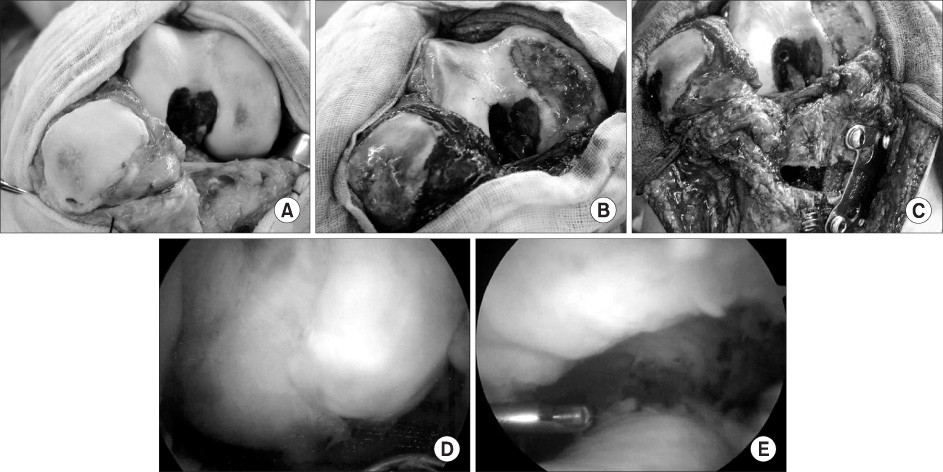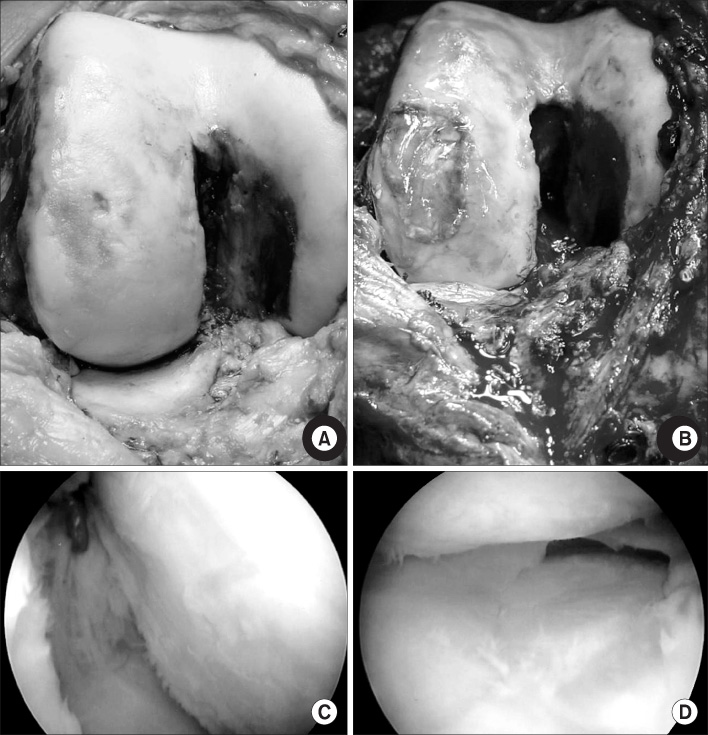J Korean Orthop Assoc.
2008 Apr;43(2):193-199. 10.4055/jkoa.2008.43.2.193.
The Results of Autologous Chondrocyte Implantation with a Concomitant Injury
- Affiliations
-
- 1Department of Orthopaedic Surgery, School of Medicine, Kyung Hee University, Seoul, Korea. kyoungho@khmc.or.kr
- KMID: 2106439
- DOI: http://doi.org/10.4055/jkoa.2008.43.2.193
Abstract
-
PURPOSE: To evaluate the results of autologous chondrocyte implantation with a concomitant injury.
MATERIALS AND METHODS
Sixty-seven chondral defects (39 cases, 36 patients), which were treated with autologous chondrocyte implantation, were analyzed with a minimum follow-up of 2 years. The cases were divided into the following five groups: 4 cases of a single chondral defect (group I), 3 cases of multiple chondral defects (group II), 5 cases of osteochondritis dissecans (group III), 9 cases of a single chondral defect with a concomitant injury (group IV), and 18 cases of multiple chondral defects with a concomitant injury (group V). The clinical outcomes were evaluated using the International Knee Documentation Committee (IKDC) subjective and objective scores and the International Cartilage Repair Society (ICRS) functional evaluation system. Arthroscopic examinations were performed on 12 cases and 21 chondral defects.
RESULTS
The mean IKDC subjective score was 39.8 preoperatively, which improved to 64.1 postoperatively, and the IKDC objective score was C in 54% and D in 46%, which improved to A in 74%, B in 23% and C in 3%. The ICRS functional evaluation system was III in 82% of cases, and IV in 18% preoperatively, which improved to I in 15% and II in 85%, postoperatively. At the arthroscopic evaluation, the results of the ICRS system were I in 9%, II in 67%, and III in 24%. There was no significant difference between the single chondral defect and chondral defects with a concomitant injury.
CONCLUSION
In the treatment of the multiple chondral defects with a concomitant injury, autologous chondrocyte implantation produced similar excellent clinical results to those of a single chondral defect.
Figure
Reference
-
1. Bobic V. Arthroscopic osteochondral autograft transplantation in anterior cruciate ligament reconstruction: a preliminary clinical study. Knee Surg Sports Traumatol Arthrosc. 1996. 3:262–264.2. Breinan H, Minas T, Barone L, et al. Histological evaluation of the course of healing of canine articular cartilage defects treated with cultured chondrocytes. Tissue Eng. 1998. 4:101–114.3. Breinan HA, Minas T, Hsu HP, Nehrer S, Sledge CB, Spector M. Effect of cultured articular chondrocytes on repair of chondral defects in a canine model. J Bone Joint Surg Am. 1997. 79:1439–1451.4. Brittberg M, Lindahl A, Nilsson A, Ohlsson C, Isaksson O, Peterson L. Treatment of deep cartilage defects in the knee with autologous chondrocyte transplantation. N Engl J Med. 1994. 331:889–895.
Article5. Brittberg M, Nilsson A, Lindahl A, Peterson L. Rabbit articular cartilage defects treated with autologous cultured chondrocytes. Clin Orthop Relat Res. 1996. 326:270–283.
Article6. Buckwalter JA, Lohmander S. Operative treatment of osteoarthritis. J Bone Joint Surg Am. 1994. 76:1405–1418.7. Grande DA, Pitman MI, Peterson L, Menche D, Klein M. The repair of experimentally produced defects in rabbit articular cartilage by autologous chondrocyte transplantation. J Orthop Res. 1989. 7:208–218.
Article8. International Cartilage Repair Society. The Cartilage Standard Evaluation Form/Knee. ICRS Newslett. 1998. 1:5–7.9. Kim HK, Moran ME, Salter RB. The potential for regeneration of articular cartilage in defects created by chondral shaving and subchondral abrasion. An experimental investigation in rabbits. J Bone Joint Surg Am. 1991. 73:1301–1315.
Article10. King PJ, Bryant T, Minas T. Autologous chondrocyte implantation for chondral defects of the knee: indications and technique. J Knee Surg. 2002. 15:177–184.11. Peterson L, Brittberg M, Kiviranta I, Akerlund EL, Lindahl A. Autologous chondrocyte transplantation. Biomechanics and long-term durability. Am J Sports Med. 2002. 30:2–12.12. Matsusue Y, Yamamuro T, Hama H. Arthroscopic multiple osteochondral transplantation to the chondral defect in the knee associated with anterior cruciate ligament disruption. Arthroscopy. 1993. 9:318–321.
Article13. Minas T. Autologous chondrocyte implantation for focal chondral defects of the knee. Clin Orthop Relat Res. 2001. 391:Suppl. S349–S361.
Article14. Nehrer S, Spector M, Minas T. Histologic analysis of tissue after failed cartilage repair procedures. Clin Orthop Relat Res. 1999. 365:149–162.
Article15. Peterson L, Minas T, Brittberg M, Nilsson A, Sjögren-Jansson E, Lindahl A. Two-to 9-year outcome after autologous chondrocyte transplantation of the knee. Clin Orthop Relat Res. 2000. 374:212–234.16. Repo RU, Finlay JB. Survival of articular cartilage after controlled impact. J Bone Joint Surg Am. 1977. 59:1068–1076.
Article17. Roberts S, Hollander AP, Caterson B, Menage J, Richardson JB. Matrix turnover in human cartilage repair tissue in autologous chondrocyte implantation. Arthritis Rheum. 2001. 44:2586–2598.
Article18. Rubak JM, Poussa M, Ritsilä V. Effects of joint motion on the repair of articular cartilage with free periosteal grafts. Acta Orthop Scand. 1982. 53:187–191.
Article19. Sahlström A, Johnell O, Redlund-Johnell I. The natural course of arthrosis of the knee. Clin Orthop Relat Res. 1997. 340:152–157.20. Shortkroff S, Barone L, Hsu HP, et al. Healing of chondral and osteochondral defects in a canine model: the role of cultured chondrocytes in regeneration of articular cartilage. Biomaterials. 1996. 17:147–154.
Article
- Full Text Links
- Actions
-
Cited
- CITED
-
- Close
- Share
- Similar articles
-
- Autologous Chondrocyte Implantation as a Secondary Procedure after Failed Microfracture for Osteochondral Lesion of Talus
- Bilateral Osteochondritis Dissecans of the Femoral Condyles in Both Knees: A Report of Two Sibling Cases
- Autologous Chondrocytes Transplantation
- Autologous Chondrocyte Implantation for Articular Cartilage Defect of Femoral Condyle
- In Vitro Tissue Engineering of Cartilage using Autologous Fibrin Glue and Chondrocytes



